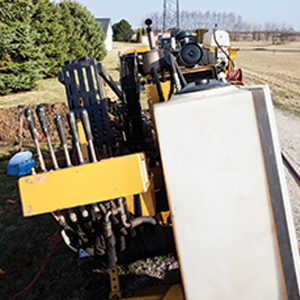
|
| Need a sample from under an obstruction? HDD can help. |
In the past, when a consultant needed to obtain a soil sample under an obstruction he had two options: angled drilling from outside the footprint of the impediment or vertical drilling in/through the obstruction. However, both of those choices have significant challenges. If the sample point is shallow, say 6 feet deep, located 40 feet from the edge of an occupied apartment building, angle drilling with an auger rig won’t get you to the sample point. The other option, drilling through the obstruction (living room floor of the apartment), is also a non-starter. So you’re thinking, who would want a sample under an occupied residence? Keep reading …
Houses aside, let’s think about a couple of other soil sampling challenges. How about getting a soil sample under a landfill? Do you want to drill through the liner? Most likely not. What about sampling under a river, stream or pier at a waterway?
All of the above soil sampling issues have been addressed by using horizontal directional drilling methods to access a sample point inaccessible to traditional vertical or angle drilling operations.
But first thing’s first. What’s the process to get a sample in a horizontal hole? Isn’t it impossible? Let’s remember we’re talking about specialized directional drilling tools that are used to locate the bit. The tools we use to determine the location of the bit in the subsurface are “locked” inside of the drill pipe. We can’t simply steer/drill to a location, remove the locating tools and run a sampler inside of the drill pipe similar to sampling inside of hollow stem augers. So we have to drill/steer to our sample point, remove the entire drill string and then run the sampler on rods or drill pipe through the fluid-filled borehole to the sample point. That process creates two complications:
- How can we keep the sampler from “scooping up” formation from the bottom of the borehole as we push the tool into the open bore? Horizontal drilling contractors are utilizing a modified piston sampler such that a spring loaded “bullet nose” end cap is held in place at the end of the sampler. This prevents formation on the bottom of the borehole from entering the sample tube as it is pushed into the hole. When the tool reaches the end of the borehole, the force of the formation causes the end cap to retract and the sample then enters the tube.
- How do we know if the sample is taken from the correct location? What if the sampling tool leaves the borehole? In most cases, the tooling stays in the borehole through the curve section out to the end of the hole. The contactor is able to determine this by the force required to push the sampler to the end of the hole. However, if the exact location of the sample is required or we are drilling in very soft formations, the sampling tooling can be placed directly in front of the locating/steering tool and track the tool’s precise location throughout the insertion and sampling process.
Now for the reality check — have contractors actually accomplished soil sampling using this method?
- Case study 1: Contaminated site in the western U.S. The objective of the project was to obtain soil samples immediately below occupied housing units in a residential area without impacting the residents. Subsurface conditions at the site consisted of fill and dredge spoils. Most of the samples were obtained about 10 feet from the building edge at a depth below ground surface of 3 to 4 feet. The total bore lengths averaged about 50 feet. Due to the “soft” and unconsolidated nature of the formation, a bentonite based drilling fluid was used to keep the borehole open during the sampling episodes. This was a high profile project which included multiple pre-construction meetings to determine and finalize the project sampling and waste stream protocol. A total of 10 samples were successfully obtained with no impact to the residences above the bore path/sample location.
- Case study 2: Landfill site in Washington. The intent of the project was to obtain soil samples under a capped and closed landfill. Several horizontal bores were initially planned to be drilled up to 300 feet from either end of the elongated landfill footprint, collecting multiple samples from each bore at a 30-foot spacing. By the conclusion of the project, over 91,000 feet of rods had been tripped into and out of the bore — the equivalent of installing more than 75 wells, 600 feet in length. But as things go in drilling, one borehole encountered what appeared to be landfill debris at an unexpected depth. Working with the client to revise the profile for this bore, the drilling team was able to pull back several rods and redirect the bore to a new elevation. As a result, samples were taken from two depths at the same X-Y location, in a single directional bore. The driller was able to redirect this particular bore twice, while collecting viable samples in all three forks of the boring.
So there you have it. Horizontal directional drilling methods can be utilized to obtain soil samples under obstructions. Is this something that contractors do on every site, or you as a consultant need on every project? Absolutely not. However, the next time you are stymied by surface obstacles, you now know about other options.
David S. Bardsley is business development manager for Directed Technologies Drilling. For more Bardsley columns, visit www.thedriller.com/bardsley.





Report Abusive Comment